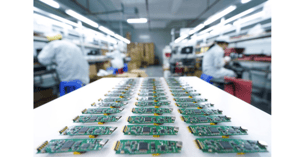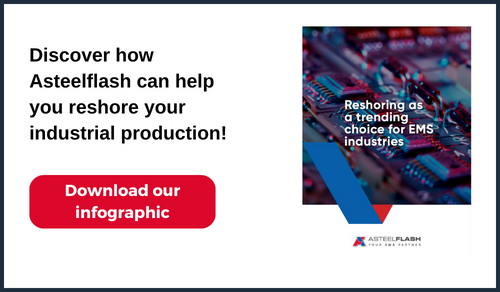Is reshoring right for you? How do you go about implementing it? How can Asteelflash help? To discover the answers to these questions, simply follow our step-by-step reshoring guidelines.
Step 1: Assessment
The first step is to identify those areas of your manufacturing operations that are outsourced to overseas suppliers. For each of these, assess the costs involved in outsourcing. Don’t just consider ex-works cost – you’ll also need to include the cost of transportation, import tariffs, and currency exchange costs. Don’t forget incidental costs, such as the cost of travel to visit the overseas manufacturer and other logistics-related expenses. This is also the right time to consider aspects of working with an overseas supplier that don’t affect costs directly but do impact overall performance. For example, the extended transit time for items coming from the supplier. This may be several weeks, delaying new product introductions and making it difficult to implement design changes quickly.
Step 2: Reshoring analysis
Having considered the costs and issues associated with overseas production, next carry out a similar analysis for reshored production. At this stage, Asteelflash can provide expert advice and support. You will need to consider the cost of design changes that may be needed to optimise your items for local manufacture, the ramifications of adapting your supply chain, and, potentially, higher labour costs. The last item is, however, often less of a concern than might be expected, particularly with electronic subassemblies. For these, labour is typically only a small proportion of the total cost and suppliers like Asteelflash use high levels of automation to further reduce this proportion.
Step 3: Comparison
With the information gathered during Steps 1 and 2, you will be able to make a valid comparison between overseas and reshored production. Once again, Asteelflash will be able to help you ensure that you’ve considered all key aspects. In particular, it’s important to remember that ex-works cost is only one factor. Transport costs, tariffs and the like will also be reduced or even eliminated and, although it’s hard to put a price on them, there are other benefits that add value to local production such as responsiveness and enhanced opportunities for collaboration.

Step 4: Implementation
If your comparison favours reshoring, you’ll need to choose your local supplier. Naturally, we suggest you choose Asteelflash! Here’s why. We have production facilities all over Europe and beyond, so we can manufacture close to you, wherever you’re based. We prioritise collaboration, so we’ll work closely with you to maximise the benefits of reshoring. We have excellent supply chain connections, so we can help you to source the right components at the right prices with the right delivery schedule. We’re flexible: if we need to invest in new equipment to manufacture your product efficiently, we’ll do it. We’re experienced with satisfied customers in almost every industry sector, all over the world. Finally, we’re renowned for quality and service – ask our customers: we’ll gladly put you in touch.
Step 5: Monitoring
It’s essential to measure and monitor the results of reshoring. If you’re working with Asteelflash, this is easy as we provide regular reports and analysis so that you can quickly quantify and confirm the benefits. We’ll also work with you to continually look for ways to enhance those benefits by, for example, taking advantage of new components or suggesting ways your products could be modified to reduce manufacturing costs.
Reshoring is not trivial but, if the circumstances are right and it’s carried out carefully, it can deliver big benefits. Reshoring is not, however, right for everyone and sometimes the best option is a ‘blended’ strategy, which reshores part of the production, but also leaves some with the overseas suppliers. This step-by-step guide has hopefully provided some useful guidance in getting your decision right but, for further advice and support, simply tap into the experience and expertise of Asteelflash.



